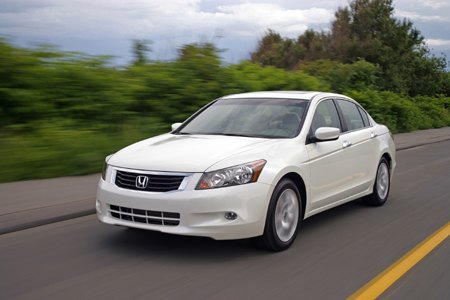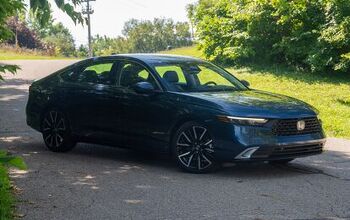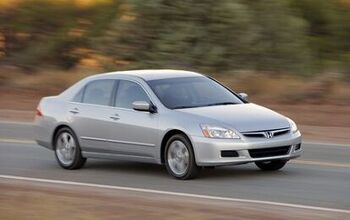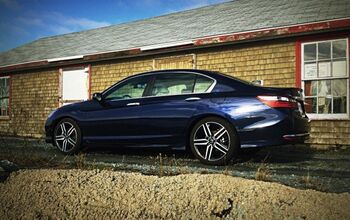Honda Accord Review
I remember sitting in a park with my father a quarter-century ago, pointing at a nearby car. “What do you think that is?” “A BMW?” Nope, but his guess was not without reason. The second-generation Accord lifted more than a few design cues from the storied German marque. The 1982 sedan was also notable for its astounding attention to detail, compactness and efficiency. For those “in the know,” the Accord revealed Detroit’s sedans as over-sized, over-powered and indelicate. Now that Honda’s eighth-generation Accord faces a supposedly chastened Detroit, does the new model maintain the mechanical high ground?
The new Honda Accord is 20 inches longer, eight inches wider, four inches taller and 1,000 pounds heavier than the motor my father misidentified. In other words, it’s larger and heavier than the ‘80’s Detroit iron reviled by Honda’s early fans. And yet the Accord has come full circle. After years of increasingly bland styling, the ubiquitous sedan once again begs to be mistaken for a BMW.
Looking at the new Accord from the rear three-quarter perspective, clocking the C-pillar kink and the wrap-around taillights (that continue to the roofline’s down-sweep), it’s a dead ringer for the current BMW 5-Series. From other perspectives, the Honda’s design is less derivative– and less eye-catching. This despite a swage line slicing downwards from the rear and a bit of Bimmeresque flame surfacing. A distinctly un-Honda abundance of front overhang does nothing for the proportions.
Still, overall, mission accomplished. The new Honda Accord looks much more expensive than both its predecessor and its classmates.
Inside, the Accord’s instrument panel sweeps across the cabin like a 5-Series’ dash. Unfortunately, this aesthetic “homage” extends to the Accord’s ergonomics. The new controls are just as complex as any Bimmer’s, with more buttons than a professional seamstress AND a large iDrive-inspired eight-way knob. So much for “We make it simple.”
The Accord’s front seats are well shaped for both comfort and [a modicum of] lateral support, especially when clad with grippy cloth. Thanks to the supersized external dimensions, the enlarged cabin is roomy enough for four Big and Tall preferred customers. The Accord’s rear seat folds in a single section to expand a class-trailing trunk; unusually intrusive rear strut towers defeat the purpose of a 60/40 split.
The 1982 Accord was motivated by a mere 75 horsepower. For years Honda refused to offer a V6 as a matter of principle. Gen 8 Accord buyers can still opt for a four-cylinder engine, with either 177 horses ( LX) or 190hp (EX). That’s plenty of poke for a family runabout, right? Wrong. Pitted against the upsized Accord’s 3,433-pound curb weight (EX-L with autobox), the four pot must rev its little 16-Valve DOHC i-VTEC® heart out to get the job done. The resulting 21/31 EPA ratings aren’t class-leading.
Enter the new 268-horsepower, 3.5-liter V6. Hello cubes, goodbye revs. Needless to say, the extra displacement works wonders in the oomph department, with minimal torque steer. The six may not deliver neck-snapping thrills or sing a lusty song, but it’s a refined piece that engenders mindless merging and perspiration-free passing.
These powerplants deserve better partners. When hooked up to either engine, the still-five-speed automatics didn’t behave well. They occasionally held a gear too long, or refused to downshift, or bumped when going from gear to gear. Maybe the transmissions needed more miles to adapt to my driving style. Maybe not. Fancy manually shifting the recalcitrant slushbox instead? Buy an Acura.
Though the Accord’s steering feels nicely weighted and precise, the suspension is tuned for touring, not sport. Going around curves, the double wishbones deliver most of the solid, tightly damped and thoroughly composed feel of a BMW– without the Bavarian’s sporting edge. Many competitors offer the option of firmer suspension tuning, but Honda doesn’t believe in options. The Accord’s suspension settings are a deft compromise between comfort and control. They are, nevertheless, a compromise. Enthusiasts will not be well satisfied; everyone else will be.
The Accord’s soft-core suspension settings does have its advantages: banishing the bump-thump busyness that sometimes afflicted the previous Accord on patchy pavement. There’s still more road noise than you’ll find in some Accord alteratives, but it’s much less pronounced than in many past Hondas.
The new Honda Accord is an impressive piece of automotive artistry. It’s well-built, roomy, properly-priced and (with the V6) powerful. It raises Honda’s trademark refinement to a new level, with much of the look and some of the feel of a base BMW 5-Series.
But part of the Accord’s appeal used to lie in Honda’s idiosyncratic insistence on engineering cars that followed the “man maximum, machine minimum” philosophy. The new Accord is large and in charge, but in seeking to provide a 5er for the masses Honda has forsaken much of the formula that earned the model its place in American automotive history.
Michael Karesh lives in West Bloomfield, Michigan, with his wife and three children. In 2003 he received a Ph.D. from the University of Chicago. While in Chicago he worked at the National Opinion Research Center, a leader in the field of survey research. For his doctoral thesis, he spent a year-and-a-half inside an automaker studying how and how well it understood consumers when developing new products. While pursuing the degree he taught consumer behavior and product development at Oakland University. Since 1999, he has contributed auto reviews to Epinions, where he is currently one of two people in charge of the autos section. Since earning the degree he has continued to care for his children (school, gymnastics, tae-kwan-do...) and write reviews for Epinions and, more recently, The Truth About Cars while developing TrueDelta, a vehicle reliability and price comparison site.
More by Michael Karesh
Latest Car Reviews
Read moreLatest Product Reviews
Read moreRecent Comments
- ToolGuy 9 miles a day for 20 years. You didn't drive it, why should I? 😉
- Brian Uchida Laguna Seca, corkscrew, (drying track off in rental car prior to Superbike test session), at speed - turn 9 big Willow Springs racing a motorcycle,- at greater speed (but riding shotgun) - The Carrousel at Sears Point in a 1981 PA9 Osella 2 litre FIA racer with Eddie Lawson at the wheel! (apologies for not being brief!)
- Mister It wasn't helped any by the horrible fuel economy for what it was... something like 22mpg city, iirc.
- Lorenzo I shop for all-season tires that have good wet and dry pavement grip and use them year-round. Nothing works on black ice, and I stopped driving in snow long ago - I'll wait until the streets and highways are plowed, when all-seasons are good enough. After all, I don't live in Canada or deep in the snow zone.
- FormerFF I’m in Atlanta. The summers go on in April and come off in October. I have a Cayman that stays on summer tires year round and gets driven on winter days when the temperature gets above 45 F and it’s dry, which is usually at least once a week.

























![2016 Honda Accord Sedan Review - Quintessential Family Hauler [Video]](https://cdn-fastly.thetruthaboutcars.com/media/2022/07/19/9237516/2016-honda-accord-sedan-review-quintessential-family-hauler-video.jpg?size=350x220)













Comments
Join the conversation
I hope that future models of the Accord are designed better than the '03. Like the previous generation, the seventh generation Accord has significant transmission design problems. Consumers should stay away from the Honda brand until they begin to rectify these issues not only in newer models, but it older ones as well. It is a shame that Honda only works with their customers when under the direction of a court settlement. Like Accords of the "sixth generation", the seventh generation (2003 to 2007) models have the same transmission problems as their predecessors. As court documents reveal, the transmissions would unexpectedly go directly from fifth gear to second gear in the 2000 and 2001 models(http://www.hondatransmissionsettlement.com/php/pdf/caht1not.pdf). This problem, however, was not corrected and the 2003 model year has suffered from this same problem. My advice: Stay far away from the Honda and the Honda Accord. They are not worth the money or aggravation that they cause.
My 2010 Honda Accord EX was waiting for me all my life! While I was out driving Chevys - my then loyalty to the make of my favorite Nascar drivers, Honda was steadily improving their mainstay family/enthusiast sedan.
Along came model year 2008, almost as big as a contemporary front wheel drive Impala, but I feel roomier inside, not as bulky as the Chevy outside.
My 2010 edition just does everything right - except for maneuverability in tight parking lots. There, it is a BUS, almost making me wish I had looked up Civics on Car Gurus instead. It had 71,700 miles on it when I bought it in 2020. Now, I'm closing in 100,000, and still no major issues.